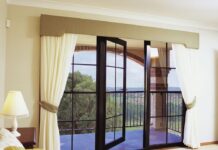
Any multi-storey or multi-level room is impossible without stairs. The staircase is a functional and structural elements of stairs, which provides vertical connections in the room. Climbing the stairs up and, if necessary, going down to the lower floor is a common thing. But how to make it comfortable and beautiful? All mankind has been thinking about this question for centuries.
The oldest staircase that has survived to our time is seven millennia old. It was found in Austria in a salt mine. It was salt that became a conservative element, which allowed the wooden staircase not to crumble, but to survive to this day. Technological prescriptions for the construction of stairs and schemes of their designs were left by the Egyptians in papyrus scrolls. For them, the stairs had not only a functional meaning, but also a sacred meaning. After all, the first Egyptian pyramids were huge stairs that went high into the sky.
Almost immediately, people began to decorate these necessary structural design elements with reliefs and mosaics. For example, as the Assyrians did, in the palace of King Darius. It is also difficult to imagine the Greek and Roman Colosseum, the amphitheater and temples without massive staircase structures. In ancient times, closed guilds of stair masters were created, who passed on their secrets on the construction and development of staircase designs from generation to generation. An interesting fact is that the spiral staircases in the tower were built so that it was possible to climb clockwise. This construction trick pursued a very specific goal – the defenders of the tower had advantages during battles, since the strongest blow of the right hand can only be applied from right to left. And the attackers did not have such an opportunity, and the shield would interfere with retaliatory strikes.
With the development of technology, people have learned to make stairs of the most unexpected designs and designs from a huge assortment of modern material. However, making a good staircase is a complex architectural and mathematical task even today. In world architecture, there are examples when architects coped with this task perfectly. Perhaps every moviegoer remembers the famous Potemkin Stairs, known to everyone from the footage from the film “Battleship Potemkin”. Another Caen staircase, consisting of twenty-four steps, leads to the Olympus. The favorite heroine of all girls since childhood, Cinderella, changed her fate, losing her crystal shoe on the stairs.
Yes, the stone steps of the stairs often became full-fledged heroes of many films. Romantic natures are sure to mark the Spanish Steps. Another famous Roman Staircase is located at the Vatican Museum. Perhaps this is the most photographed staircase in the world. She’s with a secret. In fact, there is not one staircase, but two. One by one, people go upstairs, on the other, they go down. The design was invented by Michelangelo, and fully implemented in 1932 by the Italian architect Giugeppe. Leonardo Davinci also worked on the proportions, calculations and designs of the stairs.
Dizzying and flowing, made of marble or wood – the stairs connect people separated in space. They can become the main path from a noisy living room to a quiet office, from a public space to a private one, from a large house to a secluded garden. Of course, hiring Michelangelo and Leonard Davinci to build a staircase in his country house, alas, will not work. But, using the experience of past generations, everyone can create a comfortable and interesting staircase.
As has been said more than once, the stairs play an important role in multi-storey cottage construction. In this article, we will talk about the ten main mistakes that people usually make during the construction, installation and operation of stairs.
The Ten Biggest Mistakes
Today we will look at and talk about the 10 most common mistakes made in the design, construction and subsequent operation of the stairs.
Mistake No. 1 – insufficient lift, opening, not enough distance for stairs, a large angle of inclination
If there is such an error, the stairs are simply not comfortable. And, as you know, in the stairs, first of all, its convenience is important, and only then its beautiful, aesthetic appearance. Why should the stair opening be large? Because the step of the steps, their height should be from 14 to 20 cm. People have been building stairs for centuries, and all these rules have long been clearly worked out. Openings for stairs should be large. And even in country houses for stairs you need to allocate more space. This is the only way to ensure that the stairs are convenient and comfortable. In principle, a person can climb any ladder, and it does not matter what step this ladder will have, whether it is steep or not. You can climb, but going down such a ladder will be more problematic. So, in order for a person to comfortably go down the stairs, for this it must be gentle, with a certain step, it must be clearly modeled.
Many, ordering and hiring experienced architects for the design and installation of stairs, do not agree with the fact that so much space is allocated for the stairs. They argue and disagree with the architects, and begin to reduce the area. This is a big mistake. This should not be allowed. The staircase and its design should be, first of all, comfortable, and only then beautiful.
Mistake number 2 – the wrong choice of material for the frame of the stairs
The next mistake is the wrong choice of material. What to build a staircase from? After all, it can be made of concrete, it can be metal, glass, wood … Which staircase is most suitable for your home?
In wooden houses, you can make wooden stairs to the second floor. In brick, monolithic houses, if they exceed two floors, the stairs should be either concrete or metal. You can then veneer such stairs with any material. It can be a stone in the intorior of stairs, marble, oak, any tree. With professionals, do not argue about the choice of material for the stairs. If they said it would be concrete, then it would be concrete. And you should be prepared for the fact that it will be very expensive, because the construction of stairs in the house is one of the most expensive items of expenditure.
In a three-story monolithic house, the staircase should preferably be concrete or on a metal frame. These are fire regulations, respectively, this is your safety. Everything is done so that in the event of a fire, people can have time to go down the stairs from the third floor to the first.
Mistake No. 3 – excessive load on the floors
When installing stairs in the house, it is worth, first of all, to calculate whether the concrete floors will withstand the weight and load of the stairs. Otherwise, when installing a massive concrete staircase, the floors may crack, which will lead to an emergency.
Mistake number 4 – lack of comfort
First of all, the stairs should be comfortable for you, for your children, because they will walk and run on it, and secondly, it should be beautiful. We would like to dwell once again on the safety of the stairs. Talk about why you need to adhere to the correct dimensions in the construction of stairs, the height of the steps, the step of the steps.
The step of the steps should not exceed twenty centimeters and be below fourteen. The first stage, if it is wide and similar to the site, then it can be lower. There is nothing wrong with that. But throughout the flight of stairs, this step should be preserved to the last step – then it will be convenient to go down such a staircase. A person can climb any ladder, but it will be difficult for him to go down any stairs.
The depth of the steps should be at least 27 cm, because the average size of the human leg is exactly this figure – 27 cm To make it convenient to descend, when descending to the step you need to step on a full foot, then it will be both comfortable and convenient. If the depth is smaller, you will have to go sideways or along the wall.
Mistake number 5 – non-compliance with the floor level
When pouring the steps, it is necessary to take into account the floor level of both the upper and lower, otherwise the height of the steps may not be the same, that is, all the steps will have the same height, except for the last, uppermost step. Of course, such a defect can be corrected when the steps and the entire staircase will be sheathed with wood. But, nevertheless, it is better when such mistakes are not made.
Mistake number 6 – the choice of low-quality concrete
One of the most common mistakes is the choice of material. Tip – do not skimp on material. Choose only high-quality material for concrete, this applies to both sand and cement. It is not necessary to take sand from the site, where there is also clay in addition to sand. Clay in concrete is contraindicated. The sand must be washed, of a certain fraction. It is also not worth saving on cement. Do not buy cheap cement, because it is simply not possible to buy a good thing for cheap. It is better to take expensive cement so that the concrete turns out to be of high quality. It is worth controlling the pouring process.
We have already identified six mistakes that are possible in the construction of modern stairs out of ten. There are still four left.
Mistake number 7 – pouring a concrete staircase without observing technology
Another mistake is that the march may not be flooded from one floor to another immediately. This is really a gross violation of technology. The march should be poured at the same time, entirely, without interruption, then the concrete staircase will turn out to be of high quality and good. Why do you need to fill the march at the same time, entirely from floor to floor? If you pour one step at a time, then the step will have time to harden and the next step will lie with a seam. And on this seam in the future, over time, a crack may form. Therefore, technologically it is necessary to pour so that the concrete on the lower step does not have time to harden while the upper steps are poured – step by step – so to the end.
Mistake number 8 – unsafe stairs for children
When we go up to the top floor, we see the entire staircase from above, we see what kind of opening was left to make the staircase comfortable, but the work on the stairs does not end there. This opening must be fenced with balusters. Balusters can be wooden, forged, concrete – whatever. It is worth paying attention to the fact that the stairs are used not only by adults, but also by young children. Therefore, we must take care of their safety. It is necessary to make sure that the distance between the fence is such that the child’s head cannot crawl there. If this is not possible for some aesthetic or decorative reasons, then you can come up with some kind of temporary fencing. It can be any mesh that can be pulled over these balusters. The main thing is that the children are safe.
As one of the options for interior design of stairs, the construction of a stair fence, which is considered to be safe for children, can be called the use of forged balusters. Such forged elements are very beautiful, stairs with them acquire a noble look. And, besides, between such balusters, despite the transparency and lightness of the design, there is very little space. It is durable and safe.
Mistake number 9 – the choice of low-quality material for a wooden staircase
In our article, I would like to dwell in more detail on the choice of material for a wooden staircase. This is not an unimportant question. Stair treads are mostly sold ready-made, produced in factories. But it must be borne in mind that these steps must be sealed tightly in polyethylene. Because if they are not sealed, they will absorb moisture from the environment, and, of course, can burst in the future or deform. All material, including steps, must be glued. They are glued at the factory from small blocks and the more of these blocks, the better. The bars are deployed in different directions of the tree structure, and this does not allow the step to bend. If you install a wooden staircase before the end of the general construction and finishing work in the house, then the staircase will definitely gain moisture in the tree and the likelihood that it will burst will be very large. Therefore, you need to remember that stairs are a beautiful, comfortable element of your home, the main decorstion of the interior, but it should be done in the very last place.
Mistake number 10 – improper operation of stairs
Imagine, we built a really very beautiful wooden staircase, it came out very convenient, comfortable, but here an important factor is also what kind of varnish to cover it. You can tint in any color, but you should not skimp on varnish. Because the varnish depends, first of all, on the wear resistance of the steps. And here it does not even matter what kind of wood the staircase is made of – pine or larch, and not oak, if the steps are covered with low-quality varnish. They will still wear out and wear out. Therefore, we repeat once again that you should not skimp on varnish, the stairs need to be covered with a good wear-resistant varnish. And it is very important that during subsequent operation on the wooden ladder there is no damage. After all, no varnish will help save the stairs if you walk on stilettos on it.
We hope that our tips will help you avoid those mistakes in the construction of stairs for your home, which were voiced in this article. And your ladders will really serve you for many, many years.
Each staircase has its own purpose. There are main, ceremonial, fire, service, attic, indoor, garden, hidden and open stairs. The functions of the ladder will definitely tell you the optimal size and design.
Many housewives are frightened by the scale and unattractiveness, for example, of a concrete staircase. However, such a canvas is a real find for a modern interior designer. After all, you can hide inconspicuous concrete not only under a wooden or carpeted floor, but also under a real mosaic.
The staircase can be made of scrap materials, wood, concrete, natural stones or metal. And if you want to really surprise your guests, then create a rope, glass or even plastic ladder – believe me, it will withstand!
Knowledge of the design features will also allow you to choose the space. It is up to you to choose a retractable, cantilever, swivel, monolithic or prefabricated staircase. It is also worth considering earlier what the steps themselves will be. The use of running steps, “goose step” or “sambo” structures can make the operation of the stairs comfortable, or, if the choice is not made correctly, they will create many problems.



